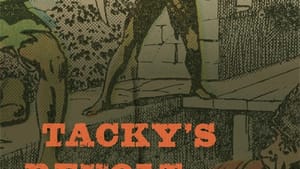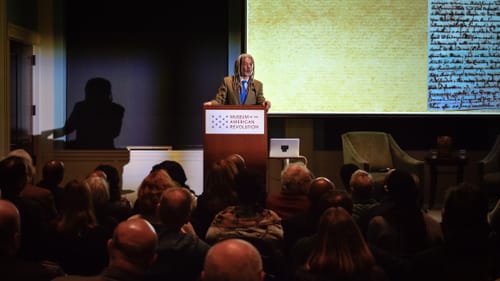Stay in the Loop
BSR publishes on a weekly schedule, with an email newsletter every Wednesday and Thursday morning. There’s no paywall, and subscribing is always free.
The real history of the transatlantic slave trade
‘Tacky’s Revolt: The Story of an Atlantic Slave War’ by Vincent Brown

“The history of Black people in America is not slavery, racism, and Jim Crow,” said Tacky’s Revolt author, historian, and Harvard University professor Vincent Brown. In February, Brown brought his book—which chronicles the little-known seeds of a global revolution—to Philly’s Museum of the American Revolution.
Tacky’s Revolt: The Story of an Atlantic Slave War features the true history of a violent uprising of enslaved West Africans (then known as Coromantees) in 18th-century Jamaica. Publisher Harvard University Press calls Tacky’s Revolt an “insurgency [that] rumbled throughout the British Empire at a time when slavery seemed the dependable bedrock of its dominion.”
No one-dimensional rebellion
As Brown demonstrates in his book, Tacky’s Revolt was not a desperate attempt to rise against the enslaved Africans’ oppressors, but a complex web of African diasporic wars to gain supreme economic, political, and geographical power in colonized Jamaica. Central to the story are a leader named Apongo and more than one thousand enslaved Black people in Jamaica, who engaged in a series of uprisings between April 7, 1760, and October 1761.
Unlike the crude, one-dimensional, angry Nat Turner-type character that has been depicted in the paintings of literal and figurative images of slave revolts, Apongo (leader of the largest rebellion of enslaved people in the 18th-century British empire) was a skilled seaman trained by the British Royal Navy and an experienced combatant in his African tradition. Tacky himself, a Coromantee, was a leader from the land, a planter who bided his time with tact and skill to attack the white colonists.
If you are looking for the loyal-slave archetype, you will not find it in these historical accounts. But what you will find are fascinating stories of infighting, strategic warfare, and politics between Africans and the European military, and the struggle to gain and regain power in the Caribbean.

Underestimating African warfare
The global enslavement of African people is a painful and controversial subject, and the transatlantic slave trade in the Americas and the West Indies are critical line items in the history of the economic foundation of the world as it stands today. Brown’s perspective sets his work apart from other scholarship, offering an additional lens to dissect the enslavement of Africans, colonial conflicts in the West Indies, and the US Civil War.
Tacky’s Revolt focuses on the social science of the uprisings of enslaved Africans on a Jamaican plantation in 1760, including feudal systems and coveted tradesman roles. The book builds a historical narrative like a corporate take-over thriller, planting the seeds of revolution in each setting. Brown reveals how the colonizers and their military, through their own self-serving, misguided egos, underestimated the traditional strategic warfare tactics that enslaved people brought with them from their native West African lands.
Beginning with a question
“Slavery is a perpetual state of war,” Brown said in an interview with BSR. Originally from southern California, he’s now a professor of African and African American Studies and director of the History Design Studio at Harvard University. His work is steeped in the research, writings, and teachings of political and cultural practices of the African diaspora.
Drawing on a wealth of research over 25 years, Brown says he started work on Tacky’s Revolt in 2005 when he asked a question: How does the African American enslavement experience fit into the larger construct of the African slave wars of the transatlantic slave trade? He contends that we will not be able to truly understand the events of the transatlantic slave trade without understanding how it connects to the history of Africa.
According to Harvard University Press, as Europe’s imperial conflicts powered capitalist agriculture around the world, “warring African factions fed their captives into the transatlantic slave trade while masters struggled continuously to keep their restive slaves under the yoke.”

The blueprint of a revolt
The book unapologetically and skillfully creates a blueprint of the economic structure of the transatlantic slave trade. It operated as a financial centerpiece, the foundation of new nations for colonists moving into the Americas. Trafficked human beings and natural resources became the major commodities and power structure of historical events including the Seven Years’ War and European conflicts in the Caribbean. Brown marshals historical corporate takeovers, pirates, and government espionage, complete with moguls, soldiers, middlemen, and the disenfranchised. The players include British imperials, Jamaican Maroons, Coromantees (who were people of Ashanti heritage), free Blacks, planters, tradesman, militia, and purchasers—identified as individual groups in societies vying within various power structures. This is not to ameliorate the horrible reality of enslavement, but to give readers an understanding of the strategy and politics of Jamaica’s garrison government, and how that impacted the rise of Tacky’s Revolt.
The twist on Brown’s reflection of Tacky’s Revolt, compared with other scholarship on the period, is that he builds it on a series of curated writings of the enslavers of that period. This approach puts you much closer to the actual language and conflict of internal and external wars. Real-life accounts from colonial overseers, businessmen, militia members, and lawyers paired with Brown’s understanding of the history of enslavement in the Caribbean create a keen sense of how the British colonists perceived the humans they enslaved, and how a revolt evolved. Unlike many professor-authored books, Tacky’s Revolt manages to present an accessible yet historically sound academic work—and you don’t need a degree with several alphabets behind your title to comprehend it.
No more propaganda
The history of the enslavement of Africans has often been presented with severe propaganda, shame, white supremacy, and misinformation—when it’s not completely omitted from important world timelines. This book is impressive and intriguing because it is written from supported accounts, without the emotional language that sometimes can overshadow the historical facts.
As Brown puts it, his book is about empire and war and how imperial violence determined the fight for the wealth of the transatlantic slave trade. We cannot simply connect the period of African American enslavement to American politics, southern plantations, and racism. We must take a larger perspective, including the global African diaspora.
What, When, Where
Tacky’s Revolt: The Story of an Atlantic Slave War. By Vincent Brown. Harvard University Press, January 14, 2020. $35.00. Hardcover. Visit here.
Sign up for our newsletter
All of the week's new articles, all in one place. Sign up for the free weekly BSR newsletters, and don't miss a conversation.

 Vena Jefferson
Vena Jefferson